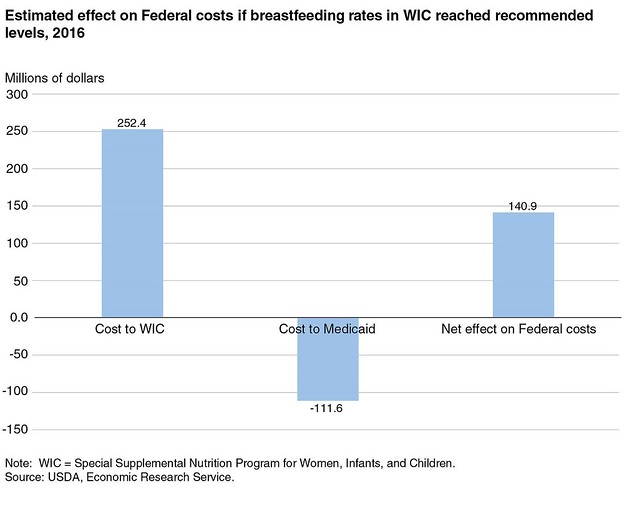
Breastfeeding rates in the United States fall short of those recommended by the American Academy of Pediatrics and other U.S. health organizations. If breastfeeding in the U.S. increased to medically recommended levels, what would be the economic impact on Federal programs?
In March 2018, Congress directed USDA’s Economic Research Service to study this topic, focusing on its potential cost savings for USDA’s Special Supplemental Nutrition Program for Women, Infants, and Children (WIC) and Medicaid programs.
Breastfeeding rates among participants in WIC have increased significantly over the past two decades, but remain below those of other low-income infants. WIC has made breastfeeding promotion and support a priority.
A new ERS report prepared in response to the Congressional request examines the effects of a hypothetical increase in breastfeeding rates among WIC participants from their 2016 levels to medically recommended levels (defined as 90 percent of infants are exclusively breastfed for their first 6 months, followed by continued breastfeeding with the addition of complementary foods—but not infant formula—for the next 6 months).
Results indicate that the number of mothers receiving WIC benefits would have increased by an estimated 646,000 per month—an 8.4 percent increase in the total number of participants—if breastfeeding rates in WIC in 2016 rose to medically recommended levels. Why? Federal regulations allow breastfeeding mothers to participate in WIC for 12 months postpartum, but limit participation to 6 months postpartum for mothers not breastfeeding at 6 months. Therefore, if breastfeeding rates among mothers participating in WIC rose, the number of mothers participating for 12 months instead of 6 would rise, resulting in an increase in the average number of postpartum women participating in the program each month.
Net costs to WIC would have increased by $252.4 million (4.2 percent of WIC’s total cost). Although food package costs would have decreased by $33.8 million, costs for Nutrition Services and Administration (NSA)—which include breastfeeding promotion and support activities—would have increased by $286.2 million.
Breastfeeding is associated with numerous health benefits for infants and mothers. Reductions in the incidence of various diseases due to increased breastfeeding among WIC participants would have reduced health-related costs to WIC households and/or their health insurance providers. For example, the Federal portion of Medicaid costs would have fallen by at least $111.6 million in 2016. As a result, total Federal program costs to WIC and Medicaid combined would have increased by an estimated $140.9 million ($252.4 million increase in WIC minus $111.6 million decrease in Federal portion of Medicaid costs). Although increased breastfeeding would have increased costs to taxpayers, health-related cost savings that accrue to WIC households or their insurance providers would have totaled $9.0 billion (excluding the savings that accrue to the Federal portion of Medicaid).
For more information, read The Economic Impacts of Breastfeeding: A Focus on USDA’s Special Supplemental Nutrition Program for Women, Infants, and Children (WIC) and view related The Economic Impacts of Breastfeeding webinar.
